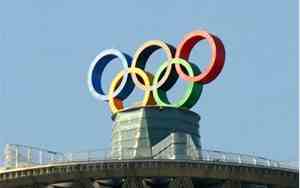
奥运五环是奥林匹克运动会的标志,它象征着全球五大洲的团结与和平。这五个环分别是蓝色、黄色、黑色、绿色和红色,分别代表欧洲、亚洲、非洲、美洲和大洋洲。每个环都独立,又紧密相连,寓意着奥林匹克精神的全球性,无论种族、信仰、性别,所有运动员都可在同一平台上竞技,追求卓越。
In English, the Olympic rings signify the unity and peace of the world. Each of the five rings - blue, yellow, black, green, and red - represents Europe, Asia, Africa, North America, and Oceania respectively. They are independent yet intertwined, symbolizing the global nature of the Olympic spirit, where athletes from all corners of the world, regardless of race, religion, or gender, come together under the same flag to strive for excellence.
奥运五环的设计者是法国人皮埃尔·德·顾拜旦,他在1913年提出了这个标志。五环代表五大洲的团结,环与环之间的连接象征着友谊、和平与国际合作。以下是五环的详细寓意:
1. 蓝色代表欧洲:欧洲在现代奥运会的初期起着关键作用,蓝色被用来象征欧洲的广阔水域和文化多样性。
2. 黄色代表亚洲:黄色代表太阳和光明,亚洲是世界上面积最大的洲,有着丰富的自然资源和悠久的历史。
3. 黑色代表非洲:黑色反映非洲大陆的丰富自然资源与历史的深度,也象征着它的文化和多样性的融合。
4. 绿色代表大洋洲:绿色代表自然,大洋洲以其独特的生态环境和生态多样性闻名。
5. 红色代表美洲:红色象征力量和活力,美洲是新世界的发现者,热情和创新是其重要的特质。
这五个环围绕在一个圆圈中,圆形表达了奥运的包容性,每个国家和人都可以在这个平台上公平竞技,追求卓越,体现了奥林匹克运动的核心价值观——团结、友谊、公平竞争和和平。
奥运五环是国际奥委会的标志,由五个环状颜色交替排列组成,它们是蓝、黄、黑、绿和红。每一个环都代表一个大洲:
1. 蓝色环代表欧洲:象征着这个大洲的海洋特性,也体现了其文化和多样性。
2. 黄色环代表亚洲:象征着阳光、活力和丰富的自然资源。
3. 黑色环代表非洲:象征着古老大陆丰富的历史和文化多样性。
4. 绿色环代表大洋洲:绿色代表着生机和自然环境的丰富多样性。
5. 红色环代表美洲:红色代表热情、活力,象征着这片新世界的创新精神和力量。
五环的图案是两个相互交织的圆环,外环为蓝色,然后接黄色,黑色,绿色,最后是红色。它们依次排列,中间留有空隙,形成一个环套环的结构,代表了世界各地的运动员和各国人民的团结与合作。
画奥运五环时,通常按照这个顺序和颜色在平面上排列,形成一个明显的五边形图案。每个环的宽度相等,颜色鲜明,这在全球的体育赛事和宣传中都能一眼辨识,是奥运会标志性的视觉符号。
但我可以描述一下奥运五环的图案以及其含义:
奥运五环是一个简洁而富有象征意义的设计。五个环紧密相连,没有交叉,各自独立但又相互包容,形成一个圆形。每个环的颜色代表:
蓝色:欧洲
黄色:亚洲
黑色:非洲
绿色:大洋洲
红色:美洲
这些环的环套环结构,象征着全球五大洲的团结,也象征着奥林匹克精神的国际性和包容性。彩色环的组合代表了地球上不同的文化背景和人民,表达了奥运会欢迎来自世界各地的运动员和平民百姓共同参与的理念。
如果你在网上搜索"Olympic rings",你会看到实际的五环图案,通常在白色或透明背景上展示,以便突出颜色。图案简洁明快,易于识别,是全球最知名的体育标志之一。
The Olympic rings are the iconic symbol of the International Olympic Committee (IOC). They represent five continents:
1. Blue: Europe, symbolizing the continent's maritime heritage and its cultural diversity.
2. Yellow: Asia, associated with the sun and representing vitality, energy, and the continent's abundant natural resources.
3. Black: Africa, representing the continent's rich history and cultural diversity.
4. Green: Oceania, embodying nature and the biologically diverse environment of the region.
5. Red: America, symbolizing power, energy, and innovation, reflecting the spirit of the New World.
The five rings, when arranged in a circle, illustrate the global unity and cooperation of athletes from different parts of the world. The interlocking design signifies the values of friendship, mutual respect, and peace, which are at the core of the Olympic Games. The rings also convey the idea of a seamless international community, where athletes and sports enthusiasts from all over the world come together to celebrate sport, despite their cultural differences.
In English, these symbols are described as "the Olympic rings, representing the five continents in a harmonious and inclusive symbol of international brotherhood."
The Olympic rings are a globally recognized symbol that represents unity, diversity, and the international spirit of the Olympic Games. Comprised of five interlocking circles, they stand for:
1. Blue: Europe, symbolizing the continent's historical influence on the Olympic movement and its variety of cultures.
2. Yellow: Asia, connecting to the idea of growth, vitality, and the continent's vast resources.
3. Black: Africa, reflecting the continent's rich history and its diverse cultural heritage.
4. Green: Oceania, representing the continent's unique relationship with nature and its ecological diversity.
5. Red: America, symbolizing strength and the pioneering spirit of the Western world.
The connected rings demonstrate the global bond between athletes and nations, emphasizing the importance of friendship, fair play, and peace between countries. This design encapsulates the core principles of the Olympics, where athletes from all over the world come together to celebrate their shared love of sport, and the Olympic values of excellence, respect, and tolerance.
copyright © 2025 一生命运网 版权所有 辽ICP备2022007116号-4
法律声明:本站文章来自网友投稿,不代表本站观点,版权归原创者所有,如果侵犯了你的权益,请通知我们,我们会及时删除侵权内容!
